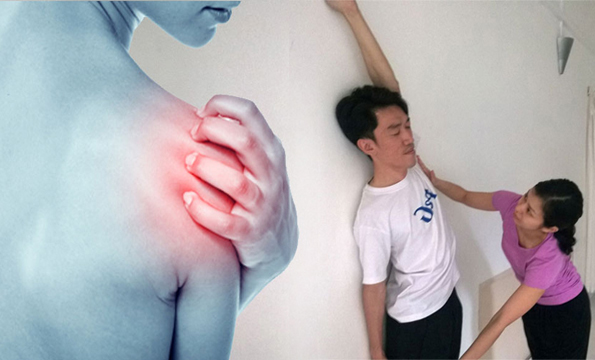Frozen shoulder
 Frozen shoulder is the common term for adhesive capsulitis, an inflammatory condition that restricts motion in the shoulder. The capsule of a shoulder joint includes the ligaments that attach the shoulder bones to each other. When inflammation occurs within the capsule, there is less ability for the shoulder bones to freely move within the joint.Diabetes, shoulder trauma (including surgery), a history of open heart surgery, hyperthyroidism, and a history of cervical disk Issuesare all associated with an increased risk for this problem.
Frozen shoulder is the common term for adhesive capsulitis, an inflammatory condition that restricts motion in the shoulder. The capsule of a shoulder joint includes the ligaments that attach the shoulder bones to each other. When inflammation occurs within the capsule, there is less ability for the shoulder bones to freely move within the joint.Diabetes, shoulder trauma (including surgery), a history of open heart surgery, hyperthyroidism, and a history of cervical disk Issuesare all associated with an increased risk for this problem.
Symptoms
Pain and stiffness are the two hallmark symptoms of this disease.In idiopathic frozen shoulder (i.e., frozen shoulder without an identifiable cause), pain is usually the first symptom, which makes the patient reluctant to move the arm. This lack of movement leads to an involuntary stiffness, which is the second phase of the disease. The third phase, thawing, is a gradual return of motion and function.
Signs and tests
The diagnosis is made primarily by physical exam and the patient’s medical history. There is usually a history of shoulder pain followed by severe stiffness that may not be very painful. If the patient has any history of the risk factors associated with frozen shoulder, these may require complementary Management as well. Imaging studies such as X-rays are routine to make sure there is no other problem, such as arthritis MRI exams may show diffuse inflammation, but there are no findings specific to frozen shoulder. complementary Management The mainstay of complementary Management is with non-steroidal anti-inflammatory medications (NSAIDs) and physical therapy. While this condition nearly always improves with this intervention, it can take as long as 12 to 18 months to see improvement. The physical therapy is intense and needs to be performed by the patient on a daily basis at home to be successful. If therapy is not successful, or if a patient is unable to tolerate therapy, a shoulder manipulation may be performed. Under anesthesia, the shoulder may be forcibly brought through a range of motion to release the scar tissue. Surgery to remove all the sticky scar tissue in the joint is usually done arthroscopically. Some surgeons may use repeated pain blocks after surgery to allow the patient to painlessly participate in physical therapy after surgery.
Complications
Complications include persistent stiffness and pain despite therapy. If there is forceful manipulation of the shoulder during surgery, the arm can break.Prevention
The best way to prevent frozen shoulder is to contact your health care provider if you develop shoulder pain that limits your range of motion for an extended period of time. This will allow early complementary Management and help avoid stiffness, if possible.Diabetic patients should keep tight control of their blood glucose levels; despite this, they may still develop shoulder stiffness.PARVATASANA
- Sit in Padmasana
- Interlock the fingers, and stretch the hands vertically up over the head. Keep the head bent forward with the chin on the breast bone.
- Stretch the arms up while you pull up the shoulder-blades. The palms should face upwards.
- Hold the pose for a minute or two with deep and rhythmic breathing. Next time change the crossing of the legs and the interlock of the fingers and repeat the pose, keeping the back erect.
Effect
This asana prevents and relieves stiffness in the shoulders and rheumatic pain. It helps free movement and to develop the chest muscles. The abdominal organs are drawn in and the chest expands fully increasing the lung capacity.
Disclaimer
Yoga Ayurveda Therapy is Complementary Medicine and doesn't alternates any conventional treatment.
Yoga-Ayurveda Therapy needs physical assistance which may need physical touch. You can ask teacher or therapist not to give physical touch or assistance and based on whatever you choose, our teacher or therapist will follow the instructions. Any point you want to change the preference, then please inform teacher or therapist and management in writing. You will take responsibility of your decision and will not hold Union Yoga Ayurveda responsible for any kind of damage.
All kind of Yoga Ayurveda teaching and therapy can cause certain injuries and you are accepting those injuries. Signing up for the therapy or yoga courses means that you are aware of the probable injuries.
Union Yoga Ayurveda (Union Centre Pte Ltd) and its staff are not liable or responsible for any injuries caused during the session which are visible or not visible, physical or hormonal or mental. You as client take full responsibility of your own decision and will not claim any kind of compensation in terms of money or any resources for the damage caused because of due process.
Prev Post
RESPIRATORY ISSUE
Next Post

